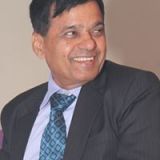"vibrant Gujarat"
First, about the rate of economic growth. During 1995-2000 and 2001-10, Gujarat increased its annual rate of growth from 8.01% to 8.68%. But so is the case with other major states such asAndhra Pradesh, Haryana, Maharashtra, Punjab, Tamil Nadu and Uttar Pradesh. In fact, Gujarat was ranked second after Rajasthan (8.34%) in the first period and third afterUttarakhand (11.81%) and Haryana (8.95%) in the second period. What is remarkable, Bihar and Orissa, the two most backward and poverty-stricken states, have also shown growth pick up from 4.70% and 4.42% in the first period to 8.02% and 8.13% in the second period. Even smaller states like Sikkim and Arunachal Pradesh have registered growth of 11.01% and 8.96%, respectively.
During 2001-04, the rate of industrial growth for Gujarat was 3.95%, and during 2005-09, it was 12.65%. In isolation, this appears to be a phenomenal jump, but not so when compared to some other states. During these sub-periods, industrial growth for Orissa was 6.4% and 17.53%; forChhattisgarh 8.10% and 13.3%; and for Uttarakhand 18.84% and 11.63%. Thus, the hitherto industrially backward states have far surpassed Gujarat.
In FDI, too, Gujarat has not been a leading state. During 2006-10, Gujarat signed MoUs worth Rs 5.35 lakh crore with potential of 6.47 lakh jobs. But Maharashtra and Tamil Nadu with Rs 4.20 lakh crore and Rs 1.63 lakh crore worth MoUs, expect about 8.63 lakh and 13.09 lakh jobs. To top it all, Chhattisgarh and Orissa have signed MoUs worth Rs 3.61 lakh crore and Rs 2.99 lakh crore more than Gujarat without much fanfare and Modi's much-hyped industrial summits.
In the area of credit-deposit ratio, Gujarat is far behind other major states. In 2010, Gujarat's share in total deposits of the scheduled commercial banks was 4.70%, as against 5.42%, 6.20%, 6.34% and 26.60% for Andhra Pradesh, Tamil Nadu, Karnataka and Maharashtra, respectively. The share of Gujarat in total credit disbursed by these commercial banks was 4.22%; while the same for Maharashtra, Karnataka and Tami Nadu was 29.75%, 6.71% and 9.61% respectively.
The amount of per capita deposit and per capita credit for Gujarat was Rs 37,174 and Rs 24,268; while for Tamil Nadu, it was Rs 42,580 and Rs 47,964; Karnataka Rs 49,598 and Rs 38,154; and Maharashtra Rs 1,10,183 and Rs 89,575. Even Kerala did better than Gujarat with Rs 43,890 and Rs 27,912.
In terms of per capita income (PCI), in 2011, Gujarat ranked sixth among major states with PCI of Rs 63,996, after Haryana (Rs 92,327), Maharashtra, (Rs 83,471), Punjab (Rs 67,473), Tamil Nadu (Rs 72,993) and Uttara-khand (Rs 68,292).
What about inclusive growth in Gujarat? Though Gujarat, with 31.8% people below the poverty line did better than Maharashtra and Karnataka, it still lagged behind Kerala, Punjab, Himachal Pradesh and Haryana, where poverty levels were 19.7%, 20.9%, 22.9% and 24.1%, respectively.
On three important social indicators, viz life expectancy at birth (LEB), mean years of schooling (MYS) and school life expectancy (SLE), Gujarat is far behind some other states. In Gujarat, the LEB during 2002-06 was 64.1 years and it ranked ninth among major Indian states. In the areas of MYS and SLE, during 2004-05, it ranked seventh and ninth, respectively. Kerala ranked first in all three indicators. Even Maharashtra, Himachal Pradesh, Punjab, Haryana, Tamil Nadu and Karnataka performed much better than Gujarat.
With respect to Human Deve-lopment Index (HDI), Gujarat's story is devastating. The HDI for Gujarat, in 2008, was 0.527 and it ranked 10 {+t} {+h} among major states. Kerala stood first (HDI: 0.790), Himachal Pradesh scored 0.652, Punjab 0.605, Maharashtra 0.572 and Haryana 0.552. With respect to three HDI components — income, health and education — Gujarat does not present a shining story. In this respect, states like Kerala took the lead in every sector, while Punjab, Himachal Pradesh, Haryana, Maharashtra, Tamil Nadu and West Bengal did better than Gujarat.
It is found that inequality with respect to income, education and health is higher in Gujarat than some of the major states. Shockingly, in terms of hunger — as revealed by the 'State Hunger Index 2008' — Gujarat ranked 13th among 17 big states and worse than Orissa.
In Gujarat, the percentage of women suffering from anaemia has risen from 46.3% in 1999 to 55.5% in 2004, and amongst children from 74.5% to 80.1%. The conditions of dalits and women have deteriorated during the last decade; while those of Muslims and tribals are still worse.
Thus, Gujarat's growth story as claimed by Modi is more a myth than reality. But it is also imperative that other states in the country make concerted efforts to secure higher and also inclusive growth, rather than getting enamoured with the Gujarat growth story. Also, for the people of Gujarat, it's time for introspection and putting right efforts in the direction of making Gujarat a truly "vibrant" state. more






